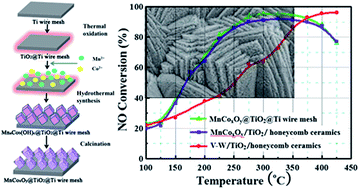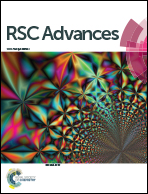In situ fabrication of porous MnCoxOy nanocubes on Ti mesh as high performance monolith de-NOx catalysts†
Abstract
Herein, we have rationally designed and fabricated porous MnCoxOy nanocubes on a Ti mesh in situ, as a novel monolith de-NOx catalyst for selective catalytic reduction of NO by NH3 (NH3-SCR). The catalysts were systematically examined by X-ray diffraction, scanning electron microscopy, transmission electron microscopy, elemental mapping and catalytic performance tests. The results indicate that the surface of the titanium mesh is uniformly coated with a layer of cube-like arrays, and each cube is formed by the stacking of regular sheet layers. This structure could prevent the migration and agglomeration of metal oxides and enable the synergistic performance of the components during the catalytic reaction. In addition, due to the robust structure and morphology, the catalyst can sustain high NO conversion, while exhibiting superior catalytic cycle stability and good H2O resistance. Considering all these favorable properties, the developed material could serve as a promising candidate for monolith de-NOx catalysts; the in situ synthesis of hierarchical monolith catalysts also illustrates a new path for the development of environment-friendly and highly active monolith de-NOx catalysts.



 Please wait while we load your content...
Please wait while we load your content...